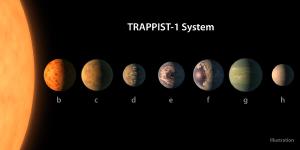Blog
Life Is Possible
On Trappist-1 Exoplanets
29 January 2018
 NASA/R. Hurt/T. Pyle
NASA/R. Hurt/T. PyleIn all the cosmos there is only one planet known to harbor life. While Earth is special to us, there are countless similar worlds orbiting other stars. Since life arose early in Earth’s history, it seems likely that life could arise on other potentially habitable planets. But as we learn of both exoplanets and the history of life on Earth, we’ve found that things are a bit more complicated.
In astronomy, “potentially habitable” simply means that the orbit of an exoplanet places it in a particular range of distance from its star. Close enough that its water wouldn’t deep freeze into a perpetual solid, and far enough away that its water doesn’t boil away leaving a dry husk of a world. Earth, as you would expect, lies within the habitable zone of the Sun.
But there are other things that make Earth so friendly to life. For one, our Sun is a stable main sequence star, so Earth has received a steady source of light and heat for billions of years. Earth also has a large moon, and the gravitational tug between the Earth and Moon creates tidal heating in Earth’s interior, producing volcanoes and other geologic activity that can bring rich material from the interior to Earth’s surface. In the outer solar system, the large moons of Jupiter experience similar tidal forces, warming their water to a liquid underneath their surface. Moons such as Europa might harbor life because of this tidal heating.
It turns out that our solar system is a bit unusual. Stars such as are much less common than smaller red dwarf stars. Most of the planets we’ve discovered orbit close to a red dwarf star. The Trappist-1 system, for example, has a least 7 Earth-sized worlds orbiting its star far more closely than Mercury orbits the Sun. Although Trappist-1 is about 90 times more massive than Jupiter, they are about the same size, and the planets orbit at a similar distance as the moons that orbit Jupiter. Since the orbits of these planets are not exactly circular, they experience tidal forces like the Jovian moons. So they could be geologically active in a life-friendly way.
Young red dwarfs can be rather hostile to life. They can produce large solar flares that can fry the atmosphere of a close planet, leaving them dry and arid. But Trappist-1 is an older, stable star, so its planets would have a steady stream of heat and light. In a recent paper, a team looked at the conditions for the Trappist planets, taking into account both the amount of heat they receive from their star, and the amount of tidal heating they generate. They found that planets d and e seem the most friendly for life, with moderate stellar heating and moderate tidal heating. They should be warm enough for liquid water, but cool enough to prevent a runaway greenhouse.1
Of course the big question is whether these planets have ample water on their surface. That would depend critically on just how massive they are. While we have a good idea of their size, we aren’t as certain about their masses. So we’ll need more data to determine if life could survive on these nearby worlds.
Barr, Amy C., Vera Dobos, and László L. Kiss. “Interior structures and tidal heating in the TRAPPIST-1 planets.” Astronomy & Astrophysics 613 (2018): A37. ↩︎